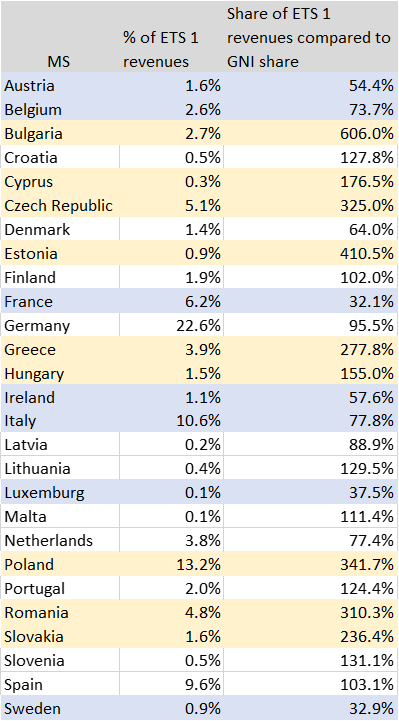
@EU_Commission presented its #ownresources proposal today. It lays out 3 new revenue streams to:
- repay EU debt #NextGenerationEU
- finance the #SocialClimateFund
A short thread on what it means for #EUETS contributions based on some initial rough calculations 🧵1/13
- repay EU debt #NextGenerationEU
- finance the #SocialClimateFund
A short thread on what it means for #EUETS contributions based on some initial rough calculations 🧵1/13
First things first. 3 proposed new revenue streams are:
- 25% ETS (1+2) revenues: ~12.5b/y
- 75% CBAM revenues: ~0.8b/y
- 15% residual profits from large, profitable multinational enterprises: ~2.5-4b/y
2/13
ec.europa.eu/info/publicati…
- 25% ETS (1+2) revenues: ~12.5b/y
- 75% CBAM revenues: ~0.8b/y
- 15% residual profits from large, profitable multinational enterprises: ~2.5-4b/y
2/13
ec.europa.eu/info/publicati…
On #CBAM, this was obviously expected; still disappointing. Many (including @e3g) argue that revenues should flow back to vulnerable #LDCs through adaptation and mitigation finance.
@Europarl_EN also seems keen on this @MChahim @kvanbrempt @MalinBjork_EU @KarinKarlsbro 3/13
@Europarl_EN also seems keen on this @MChahim @kvanbrempt @MalinBjork_EU @KarinKarlsbro 3/13
On #EUETS. Starting in 2023, a flat 25% of all #ETS revenues are proposed to go to the EU budget. In the first 3years this will only be from the existing ETS, from 2026 onwards also the separate one for buildings and transport (*if implemented) 4/13
Implicitly, the Social Climate Fund will be fully funded by #ETS2 revenues, while revenues from the existing one will repay EU debt.
Good for the optics, as it does not give the impression that EU citizens repay EU debt through their heating/fuel bills.. 5/13
Good for the optics, as it does not give the impression that EU citizens repay EU debt through their heating/fuel bills.. 5/13
(Though of course majority of #ETS1 revenues are raised through energy utilities purchasing #EUAs purchasing allowances, which is reflected in the power bill of consumers [while industry gets free allocation and is often compensated for the carbon in their electricity costs])6/13
So now the politically sensitive(?) part: which MS are expected to pay for this #ETS based own resource?
I'll only focus on the existing ETS now. ETS revenues are not divided based on GNI share but rather on '05-'08 GHG emissions shares, topped up with solidarity mechanisms 7/13
I'll only focus on the existing ETS now. ETS revenues are not divided based on GNI share but rather on '05-'08 GHG emissions shares, topped up with solidarity mechanisms 7/13
In practice, this means a lot of the poorer MS actually get more revenues. Besides the initial #ModernisationFund and #InnovationFund allowances, the 25% applies to all allowances auctioned, including solidarity/flexibilities. This includes those which certain eligible...
8/13
8/13

MS decided to add to the Modernisation Fund (hello 🇨🇿🇭🇷🇱🇹🇷🇴🇸🇰).
So the proposal will reduce the size of the Modernisation Fund and see poorer MS pay relatively more (compared to EU budget contributions based on GNI) 9/13
ec.europa.eu/clima/eu-actio…
So the proposal will reduce the size of the Modernisation Fund and see poorer MS pay relatively more (compared to EU budget contributions based on GNI) 9/13
ec.europa.eu/clima/eu-actio…
The Commission recognises this, and proposes a floor and a ceiling (for low-income MS) on the share of ETS contributions compared to national contributions.
I've done some rough calculations to see what this means, based on expected division of ETS revenues in 2023 and...
10/13
I've done some rough calculations to see what this means, based on expected division of ETS revenues in 2023 and...
10/13

the 2019 GNI-based EU budget contributions.
Without this floor/ceiling, it's clear that poorer MS would contribute *a lot* more through the ETS own resource compared to the GNI-based contribution - up to +600% for 🇧🇬; or as low as 32% for 🇫🇷&🇸🇪 11/13
Without this floor/ceiling, it's clear that poorer MS would contribute *a lot* more through the ETS own resource compared to the GNI-based contribution - up to +600% for 🇧🇬; or as low as 32% for 🇫🇷&🇸🇪 11/13

The derogation corrects this somewhat, but the #ETS1 -based contribution would clearly remains regressive compared to the GNI-based contributions (*if my rough estimates are correct - keen to see other estimates) 12/13 

Of course the picture will change in 2026 when (if) #ETS2 starts. Though will be interesting to hear what Member States think of this.
Clearly, this proposal adds another layer of complexity to the already complicated #fitfor55 discussions... looking forward to 2022. 13/13
Clearly, this proposal adds another layer of complexity to the already complicated #fitfor55 discussions... looking forward to 2022. 13/13
@a_third_Opinion @CamilleMaury3 @theagnese @bedini_giulia @fed_disario @KiraTaylor15 @klausroehrig @tobiaszadamcze1 @pierre_leturcq
• • •
Missing some Tweet in this thread? You can try to
force a refresh



